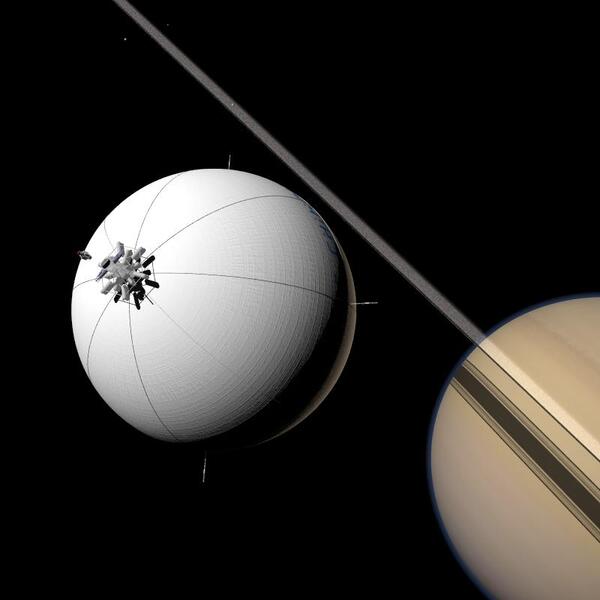This article explores: Bernal Spheres: A viable option for long-term space colonization? Find out more about Bernal Spheres And Long-term Space Colonization.
As humanity continues to explore the vast reaches of space, the need for sustainable and self-contained habitats becomes increasingly important.

One potential solution to this challenge is the Bernal sphere, a rotating space habitat designed to provide a self-contained living environment for humans in space.
The concept of the Bernal sphere was first proposed by scientist John Desmond Bernal in the mid-20th century and has since been refined and developed by various researchers and space enthusiasts.
While constructing a Bernal sphere would be a significant engineering challenge, it has the potential to provide a comfortable and sustainable living environment for long-term space colonization.
This article will explore the concept of Bernal spheres in more detail, examining their potential as a viable option for long-term space colonization.
Can We Use Bernal Spheres For Long-term Space Colonization?
Bernal spheres could potentially be used for long-term space colonization, providing a self-contained, sustainable living environment for humans in space.
The concept of the Bernal sphere was originally proposed as a way to provide a comfortable living environment for humans in space, where they would be shielded from harmful radiation, and could potentially grow their own food and recycle waste.
Advantages of the Bernal sphere design
One of the advantages of the Bernal sphere design is that it provides artificial gravity through rotation, which could help prevent the harmful health effects of long-term exposure to zero-gravity environments.
It also allows for larger living spaces and more room for agriculture and other activities compared to other spacecraft designs.
Challenges of the Bernal sphere design
However, building and maintaining a Bernal sphere habitat would require significant resources, including raw materials, energy, and specialized equipment.
It would also require a self-sustaining ecosystem capable of producing food, water, and oxygen while recycling waste, which would require advanced life support systems and agricultural technologies that can function in a zero-gravity environment.
Despite the challenges, the Bernal sphere remains an active area of research and development in the space industry today, and there is significant interest in the potential of this technology for long-term space colonization.
It may take several decades or even centuries before we can fully realize the potential of Bernal sphere habitats for space colonization, but the concept remains an important and inspiring vision for the future of human space exploration.
How Does A Bernal Sphere Work?
A Bernal sphere is a type of rotating space habitat designed to provide a self-contained living environment for humans in space.
The design was proposed by scientist John Desmond Bernal in the mid-20th century and has since been refined and developed by various researchers and space enthusiasts.
- The basic concept of a Bernal sphere is to create an artificial gravity environment through the use of rotation.
- The habitat consists of a large sphere or cylinder, which rotates around its central axis to create centrifugal force.
- This force provides a gravitational pull on objects within the sphere, allowing humans and other organisms to live and move around as they would on Earth.
- The sphere is typically divided into several different sections, including living quarters, agricultural areas, and utility spaces.
- These sections are arranged around the equator of the sphere, allowing them to experience the greatest amount of centrifugal force and thus the strongest artificial gravity.
- The Bernal sphere is designed to be a self-sustaining ecosystem, capable of producing its own food, water, and oxygen while recycling waste.
- This requires advanced life support systems and agricultural technologies that can function in a zero-gravity environment.
- The Bernal sphere design is that it provides a large living space and potentially greater comfort than other spacecraft designs.
- A Bernal sphere also shields inhabitants from harmful radiation and allows for more space for agriculture and other activities.
Despite the potential advantages, building and maintaining a Bernal sphere habitat would be a significant engineering challenge and require significant resources.
The concept remains an active area of research and development in the space industry today, as it could potentially enable long-term human habitation in space.
How Many People Live In The Bernal Sphere?
The number of people that could live in a Bernal sphere would depend on the size and design of the habitat, as well as the resources available to sustain its inhabitants.
John Desmond Bernal, the scientist who first proposed the concept of the Bernal sphere, envisioned a habitat that could support around 10,000 people.
This was a very preliminary estimate and did not take into account many of the practical challenges associated with building and maintaining such a large and complex structure.
In reality, the number of people that could live in a Bernal sphere would depend on a wide range of factors, including the size and capacity of the habitat, the level of technology available for life support and resource management, and the specific needs and requirements of the inhabitants.
Some estimates suggest that a Bernal sphere habitat with a diameter of around 1 kilometer (0.62 miles) could potentially support a population of several thousand people, although this would require very advanced technology and a carefully designed ecosystem that could sustain the needs of the inhabitants over the long term.
Overall, the number of people that could live in a Bernal sphere would depend on a wide range of factors, and any specific estimates would need to take into account the specific design and technological specifications of the habitat.
How Difficult Would It Be To Construct a Bernal Sphere?
Constructing a Bernal sphere would be a very challenging engineering feat, requiring significant resources and technological advancements.
While the concept of the Bernal sphere has been around since the mid-20th century, no such structure has ever been built, and much of the technology required for its construction and maintenance is still in the early stages of development.
Self-contained ecosystem
One of the main challenges of constructing a Bernal sphere is the need to create a self-contained ecosystem that can support human life over an extended period of time.
This would require advanced technologies for life support, agriculture, waste management, and other critical systems, as well as the ability to recycle and replenish resources such as water, oxygen, and food.
Extreme conditions of space
Another major challenge is the need to create a structure that can withstand the extreme conditions of space, including radiation, temperature fluctuations, and micrometeorite impacts.
This would require materials and construction techniques that are capable of withstanding these harsh conditions over a long period of time.
Significant resources
Building a Bernal sphere would require significant resources, including raw materials, energy, and specialized equipment.
The construction process would also require a large workforce with specialized skills and expertise in space engineering and construction.
Despite these challenges, the concept of the Bernal sphere remains an active area of research and development in the space industry today, with many researchers and engineers working to develop the technology and capabilities required to make this vision a reality.
While it may take many years or even decades to fully realize the potential of the Bernal sphere for space colonization, the vision of a self-contained, sustainable living environment in space remains an inspiring and important goal for the future of human space exploration.
References for: “Bernal Spheres: A viable option for long-term space colonization?”
Bernal, J.D. (1950). The World, the Flesh & the Devil: An Enquiry into the Future of the Three Enemies of the Rational Soul. London: Routledge & Kegan Paul.
Sagan, C. (1980). Cosmos: Episode 1 The Shores of the Cosmic Ocean.
O’Neill, G.K. (1976). The High Frontier: Human Colonies in Space. New York: William Morrow & Co.
Richard D. Johnson, Charles Holbrow. Bernal Spheres: A Proposed Form of Space Settlement. Space Settlements: A Design Study, NASA SP-413, pp. 253-261.
Hein, A.M. (2013). Colonizing the Outer Solar System: A Technical Analysis. Acta Astronautica, 92(2), pp. 103-115.
Hertzfeld, H.R., and Petersen, E.L. (2017). Economic Assessment and Systems Analysis of Alternative Space Settlement Concepts. Space Policy, 39, pp. 1-10.
Lewis, J.S. (1996). Colonization of the Outer Solar System: A Technical Overview. Advances in Space Research, 18(2), pp. 5-14.
Malin, M.C. (2019). Conceptual Design of a Bernal Sphere for Mars Settlement. Acta Astronautica, 163, pp. 322-333.
Reynolds, R.T. (1987). Bernal Sphere Habitats: Their Origins and Potential for Colonization. Proceedings of the First International Space Development Conference, pp. 93-97.
Zubrin, R.M. (2011). The Case for Mars: The Plan to Settle the Red Planet and Why We Must. New York: Free Press.
‘Bernal Spheres: A viable option for long-term space colonization?’ is one important topic in our series exploring the role of Bernal Spheres in space colonization.
Read more about these topics by following the links below:
Republished by Blog Post Promoter
